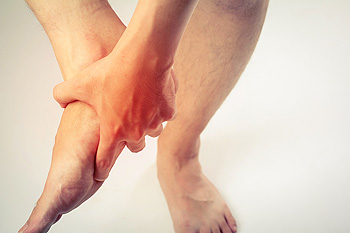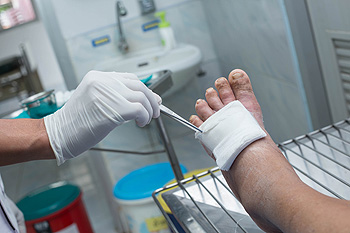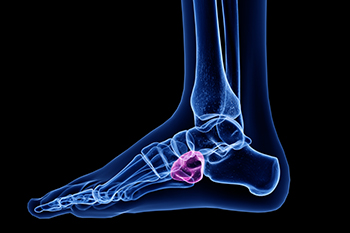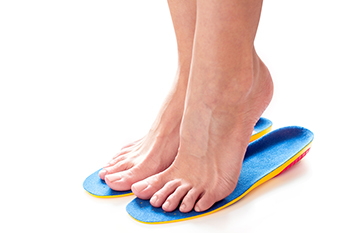April 2022
Causes of Foot Pain

Pain can be felt in the feet for a multitude of reasons, including aging, prolonged standing, walking, being overweight, structural problems with feet, foot injuries, poor fitting foot coverings, or a physical condition, such as arthritis or gout. Painful foot conditions can arise out of the aforementioned risk factors, like bunions, calluses, corns, hammertoes, Morton’s neuroma, plantar fasciitis, or heel spurs. If you are experiencing pain in your feet and you cannot easily figure out what it is from or what to do about it, consider consulting with a podiatrist for proper diagnosis and treatment.
Foot Pain
Foot pain can be extremely painful and debilitating. If you have a foot pain, consult with Dr. Lee R. Stein from Lake Shore Foot & Ankle, PC. Our doctor will assess your condition and provide you with quality foot and ankle treatment.
Causes
Foot pain is a very broad condition that could be caused by one or more ailments. The most common include:
- Bunions
- Hammertoes
- Plantar Fasciitis
- Bone Spurs
- Corns
- Tarsal Tunnel Syndrome
- Ingrown Toenails
- Arthritis (such as Gout, Rheumatoid, and Osteoarthritis)
- Flat Feet
- Injury (from stress fractures, broken toe, foot, ankle, Achilles tendon ruptures, and sprains)
- And more
Diagnosis
To figure out the cause of foot pain, podiatrists utilize several different methods. This can range from simple visual inspections and sensation tests to X-rays and MRI scans. Prior medical history, family medical history, and any recent physical traumatic events will all be taken into consideration for a proper diagnosis.
Treatment
Treatment depends upon the cause of the foot pain. Whether it is resting, staying off the foot, or having surgery; podiatrists have a number of treatment options available for foot pain.
If you have any questions, please feel free to contact one of our offices located in Chicago, Highland Park, and Uptown, IL . We offer the newest diagnostic and treatment technologies for all your foot care needs.
How Can Glucose Levels Be Managed?
 People who have diabetes should understand the importance of inspecting their feet every single day. This is an effective method to check for any cuts, bruises, or wounds that may have developed. Patients who have this condition can have neuropathy, which is a loss of feeling in the feet, and checking the bottom of the feet with a mirror is important to do too. Diabetes occurs as a result of elevated glucose levels in the blood. It is imperative that tests are performed daily which can check sugar levels. Additionally, it can help when cholesterol levels are monitored, and smoking is stopped. It may help to control glucose levels by eating foods that are healthy and becoming physically active. Many diabetic patients find it helpful to have their podiatrist trim their toenails and check their feet. If you have diabetes, it is strongly advised that you are under the care of a podiatrist who can help you to manage this condition.
People who have diabetes should understand the importance of inspecting their feet every single day. This is an effective method to check for any cuts, bruises, or wounds that may have developed. Patients who have this condition can have neuropathy, which is a loss of feeling in the feet, and checking the bottom of the feet with a mirror is important to do too. Diabetes occurs as a result of elevated glucose levels in the blood. It is imperative that tests are performed daily which can check sugar levels. Additionally, it can help when cholesterol levels are monitored, and smoking is stopped. It may help to control glucose levels by eating foods that are healthy and becoming physically active. Many diabetic patients find it helpful to have their podiatrist trim their toenails and check their feet. If you have diabetes, it is strongly advised that you are under the care of a podiatrist who can help you to manage this condition.
Diabetic foot care is important in preventing foot ailments such as ulcers. If you are suffering from diabetes or have any other concerns about your feet, contact Dr. Lee R. Stein from Lake Shore Foot & Ankle, PC. Our doctor can provide the care you need to keep you pain-free and on your feet.
Diabetic Foot Care
Diabetes affects millions of people every year. The condition can damage blood vessels in many parts of the body, especially the feet. Because of this, taking care of your feet is essential if you have diabetes, and having a podiatrist help monitor your foot health is highly recommended.
The Importance of Caring for Your Feet
- Routinely inspect your feet for bruises or sores.
- Wear socks that fit your feet comfortably.
- Wear comfortable shoes that provide adequate support.
Patients with diabetes should have their doctor monitor their blood levels, as blood sugar levels play such a huge role in diabetic care. Monitoring these levels on a regular basis is highly advised.
It is always best to inform your healthcare professional of any concerns you may have regarding your feet, especially for diabetic patients. Early treatment and routine foot examinations are keys to maintaining proper health, especially because severe complications can arise if proper treatment is not applied.
If you have any questions please feel free to contact one of our offices located in Chicago, Highland Park, and Uptown, IL . We offer the newest diagnostic and treatment technologies for all your foot and ankle needs.
What Is Cuboid Syndrome?
 Cuboid syndrome (also known as cuboid subluxation) involves a tear or injury to the joint and/or ligaments near the cuboid bone in the foot. The bones move but are not fully displaced when one has this condition. Ankle sprains or injuries are often the culprit of this syndrome, but it can also be caused by repetitive strain of the foot or having flat feet. As with many foot problems, this syndrome is more likely to affect those who are: overweight, have arthritis or bone conditions, wear improperly fitting shoes, do not stretch well before exercise, do not allow enough rest of the foot before resuming physical activity, exercise on uneven surfaces, or fracture a bone connected to the cuboid. One can suspect cuboid syndrome if there is pain on the side of the foot near the baby toe, which may intensify with weight bearing or pushing on the arch on the bottom of the foot. The pain can also spread to other parts of the foot when pressure is exerted on the front of the toes, there may be redness near the injured area, swelling of the injured area and ankle due to fluid buildup, less movement of the ankle or lateral side of the foot, weakness in toes on this side of the foot and an altered gait to compensate for pain. Treatments for cuboid syndrome vary and it is suggested that a podiatrist be consulted for proper diagnosis of the condition and pinpointing the best course of action for your case.
Cuboid syndrome (also known as cuboid subluxation) involves a tear or injury to the joint and/or ligaments near the cuboid bone in the foot. The bones move but are not fully displaced when one has this condition. Ankle sprains or injuries are often the culprit of this syndrome, but it can also be caused by repetitive strain of the foot or having flat feet. As with many foot problems, this syndrome is more likely to affect those who are: overweight, have arthritis or bone conditions, wear improperly fitting shoes, do not stretch well before exercise, do not allow enough rest of the foot before resuming physical activity, exercise on uneven surfaces, or fracture a bone connected to the cuboid. One can suspect cuboid syndrome if there is pain on the side of the foot near the baby toe, which may intensify with weight bearing or pushing on the arch on the bottom of the foot. The pain can also spread to other parts of the foot when pressure is exerted on the front of the toes, there may be redness near the injured area, swelling of the injured area and ankle due to fluid buildup, less movement of the ankle or lateral side of the foot, weakness in toes on this side of the foot and an altered gait to compensate for pain. Treatments for cuboid syndrome vary and it is suggested that a podiatrist be consulted for proper diagnosis of the condition and pinpointing the best course of action for your case.
Cuboid syndrome, also known as cuboid subluxation, occurs when the joints and ligaments near the cuboid bone in the foot become torn. If you have cuboid syndrome, consult with Dr. Lee R. Stein from Lake Shore Foot & Ankle, PC. Our doctor will assess your condition and provide you with quality foot and ankle treatment.
Cuboid syndrome is a common cause of lateral foot pain, which is pain on the outside of the foot. The condition may happen suddenly due to an ankle sprain, or it may develop slowly overtime from repetitive tension through the bone and surrounding structures.
Causes
The most common causes of cuboid syndrome include:
- Injury – The most common cause of this ailment is an ankle sprain.
- Repetitive Strain – Tension placed through the peroneus longus muscle from repetitive activities such as jumping and running may cause excessive traction on the bone causing it to sublux.
- Altered Foot Biomechanics – Most people suffering from cuboid subluxation have flat feet.
Symptoms
A common symptom of cuboid syndrome is pain along the outside of the foot which can be felt in the ankle and toes. This pain may create walking difficulties and may cause those with the condition to walk with a limp.
Diagnosis
Diagnosis of cuboid syndrome is often difficult, and it is often misdiagnosed. X-rays, MRIs and CT scans often fail to properly show the cuboid subluxation. Although there isn’t a specific test used to diagnose cuboid syndrome, your podiatrist will usually check if pain is felt while pressing firmly on the cuboid bone of your foot.
Treatment
Just as the range of causes varies widely, so do treatments. Some more common treatments are ice therapy, rest, exercise, taping, and orthotics.
If you have any questions, please feel free to contact one of our offices located in Chicago, Highland Park, and Uptown, IL . We offer the newest diagnostic and treatment technologies for all your foot care needs.
Gout Pain Can Be Managed
Flat Feet and Orthotics
Many people are born with flat feet. There may be additional causes for flat feet to develop that can include pregnancy, arthritis, diabetes, or even an injury. Orthotics are custom made inserts that are designed to fit inside shoes. Research has indicated that wearing orthotics may help patients with flat feet. The benefits of wearing orthotics can include shock absorption, improved balance, and support for the arch and heel. Additionally, orthotics may reduce existing pain that some patients experience because of flat feet. If you have this condition, and are interested in learning more about how orthotics can help you, please consult with a podiatrist.
If you are having discomfort in your feet and would like to try orthotics, contact Dr. Lee R. Stein from Lake Shore Foot & Ankle, PC. Our doctor can provide the care you need to keep you pain-free and on your feet.
What Are Orthotics?
Orthotics are inserts you can place into your shoes to help with a variety of foot problems such as flat feet or foot pain. Orthotics provide relief and comfort for minor foot and heel pain but can’t correct serious biomechanical problems in your feet.
Over-the-Counter Inserts
Orthotics come in a wide variety of over-the-counter inserts that are used to treat foot pain, heel pain, and minor problems. For example, arch supports can be inserted into your shoes to help correct overarched or flat feet, while gel insoles are often used because they provide comfort and relief from foot and heel pain by alleviating pressure.
Prescription Orthotics
If over-the-counter inserts don’t work for you or if you have a more severe foot concern, it is possible to have your podiatrist prescribe custom orthotics. These high-quality inserts are designed to treat problems such as abnormal motion, plantar fasciitis, and severe forms of heel pain. They can even be used to help patients suffering from diabetes by treating foot ulcers and painful calluses and are usually molded to your feet individually, which allows them to provide full support and comfort.
If you are experiencing minor to severe foot or heel pain, it’s recommended to speak with your podiatrist about the possibilities of using orthotics. A podiatrist can determine which type of orthotic is right for you and allow you to take the first steps towards being pain-free.
If you have any questions please contact one of our offices located in Chicago, Highland Park, and Uptown, IL . We offer the newest diagnostic and treatment technologies for all your foot and ankle needs.
Blog Archives
- July 2025
- June 2025
- May 2025
- April 2025
- March 2025
- February 2025
- January 2025
- December 2024
- November 2024
- October 2024
- September 2024
- August 2024
- July 2024
- June 2024
- May 2024
- April 2024
- March 2024
- February 2024
- January 2024
- December 2023
- November 2023
- October 2023
- September 2023
- August 2023
- July 2023
- June 2023
- May 2023
- April 2023
- March 2023
- February 2023
- January 2023
- December 2022
- November 2022
- October 2022
- September 2022
- August 2022
- July 2022
- June 2022
- May 2022
- April 2022
- March 2022
- February 2022
- January 2022
- December 2021
- November 2021
- October 2021
- September 2021
- August 2021
- July 2021
- June 2021
- May 2021
- April 2021
- March 2021
- February 2021
- January 2021
- December 2020
- November 2020
- October 2020
- September 2020
- August 2020
- July 2020
- June 2020
- May 2020
- April 2020
- March 2020
- February 2020
- January 2020
- December 2019
- November 2019
- October 2019
- September 2019
- August 2019
- July 2019
- June 2019
- May 2019
- April 2019
- March 2019
- February 2019
- January 2019
- December 2018
- November 2018
- October 2018
- September 2018
- August 2018
- July 2018









